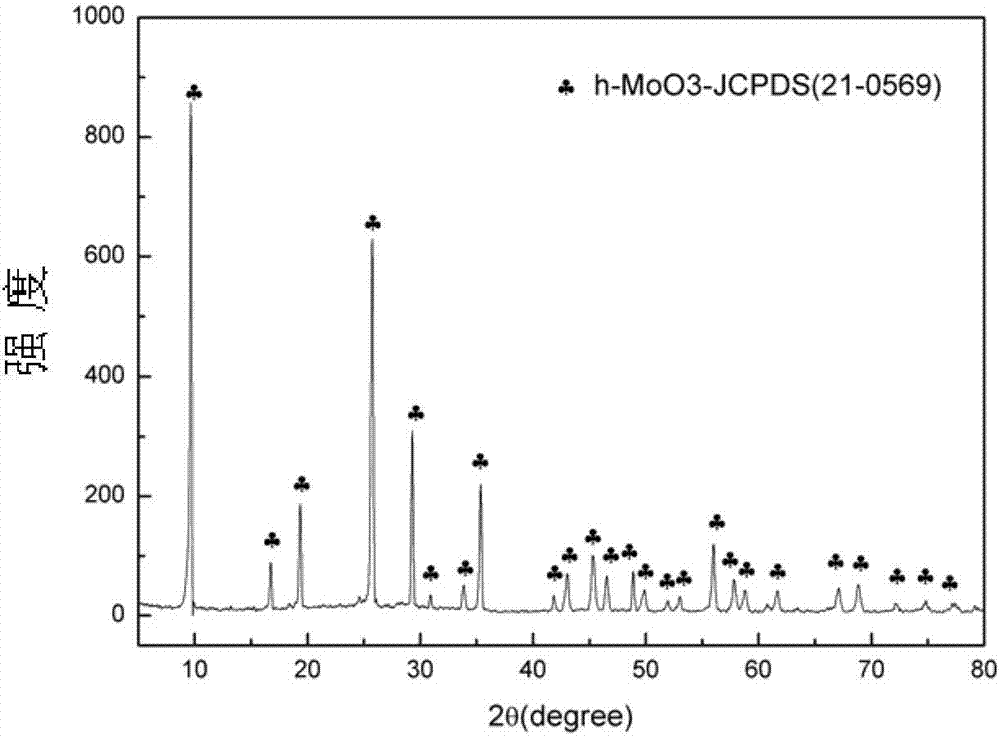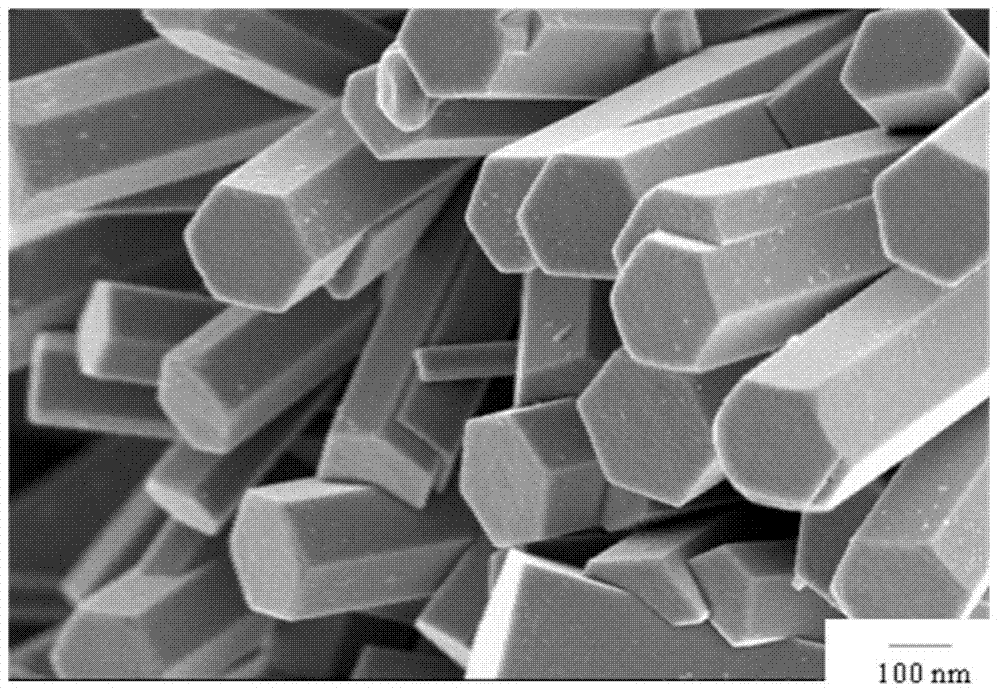A microwave-ultrasonic method for preparing h-moo3 nanorods
A technology of h-moo3 and nanorods, which is applied in the direction of nanotechnology, nanotechnology, nanotechnology for materials and surface science, etc., can solve the problems of side reactions, high reaction temperature, long reaction time, etc. The effect of short cycle, high purity and uniform distribution
- Summary
- Abstract
- Description
- Claims
- Application Information
AI Technical Summary
Problems solved by technology
Method used
Image
Examples
Embodiment 1
[0018] 1) Analytical pure ammonium molybdate ((NH 4 ) 6 Mo 7 o 24 4H 2 O) join in deionized water and stir to make the concentration of ammonium molybdate is the solution A of 0.001mol / L;
[0019] 2) After stirring and dissolving solution A evenly, use 4mol / L HNO 3 The solution adjusts the pH of solution A to 2.0 to obtain solution B;
[0020] 3) Pour solution B into a four-necked round-bottomed flask, put the equipped four-necked round-bottomed flask into a UWave-1000 microwave-ultraviolet-ultrasonic trinity synthesis extraction reaction apparatus, and fix it, and use platinum resistance to measure temperature ;
[0021] 4) Use the microwave-ultrasonic synthesis mode, set the output power of the ultrasonic wave to 400W, select the temperature-time working mode, set the reaction temperature to 60°C, the time to 100min, the microwave heating time to 10min, and the output power of the microwave during the heat preservation process to 24W. Run the program, and naturally co...
Embodiment 2
[0024] 1) Analytical pure ammonium molybdate ((NH 4 ) 6 Mo 7 o 24 4H 2 O) join in deionized water and stir to make the concentration of ammonium molybdate is the solution A of 0.01mol / L;
[0025] 2) After stirring and dissolving solution A evenly, use 5mol / L HNO 3 The solution adjusts the pH of solution A to 1.0 to obtain solution B;
[0026] 3) Pour solution B into a four-necked round-bottomed flask, put the equipped four-necked round-bottomed flask into a UWave-1000 microwave-ultraviolet-ultrasonic trinity synthesis extraction reaction apparatus, and fix it, and use platinum resistance to measure temperature ;
[0027] 4) Use the microwave-ultrasonic synthesis mode, set the output power of the ultrasonic wave to 400W, select the temperature-time working mode, set the reaction temperature to 70°C, the time to 80min, the microwave heating time to 10min, and the output power of the microwave during the heat preservation process to 24W. Run the program, and naturally cool...
Embodiment 3
[0030] 1) Analytical pure ammonium molybdate ((NH 4 ) 6 Mo7 o 24 4H 2 O) join in deionized water and stir to make the concentration of ammonium molybdate is the solution A of 0.005mol / L;
[0031] 2) After stirring and dissolving solution A evenly, use 6mol / L HNO 3 The solution adjusts the pH=0.5 of solution A to obtain solution B;
[0032] 3) Pour solution B into a four-necked round-bottomed flask, put the equipped four-necked round-bottomed flask into a UWave-1000 microwave-ultraviolet-ultrasonic trinity synthesis extraction reaction apparatus, and fix it, and use platinum resistance to measure temperature ;
[0033] 4) Use the microwave-ultrasonic synthesis mode, set the output power of the ultrasonic wave to 400W, select the temperature-time working mode, set the reaction temperature to 50°C, the time to 60min, the microwave heating time to 10min, and the output power of the microwave during the heat preservation process to 24W. Run the program, and naturally cool to ...
PUM
| Property | Measurement | Unit |
|---|---|---|
| diameter | aaaaa | aaaaa |
Abstract
Description
Claims
Application Information
 Login to View More
Login to View More - R&D Engineer
- R&D Manager
- IP Professional
- Industry Leading Data Capabilities
- Powerful AI technology
- Patent DNA Extraction
Browse by: Latest US Patents, China's latest patents, Technical Efficacy Thesaurus, Application Domain, Technology Topic, Popular Technical Reports.
© 2024 PatSnap. All rights reserved.Legal|Privacy policy|Modern Slavery Act Transparency Statement|Sitemap|About US| Contact US: help@patsnap.com









